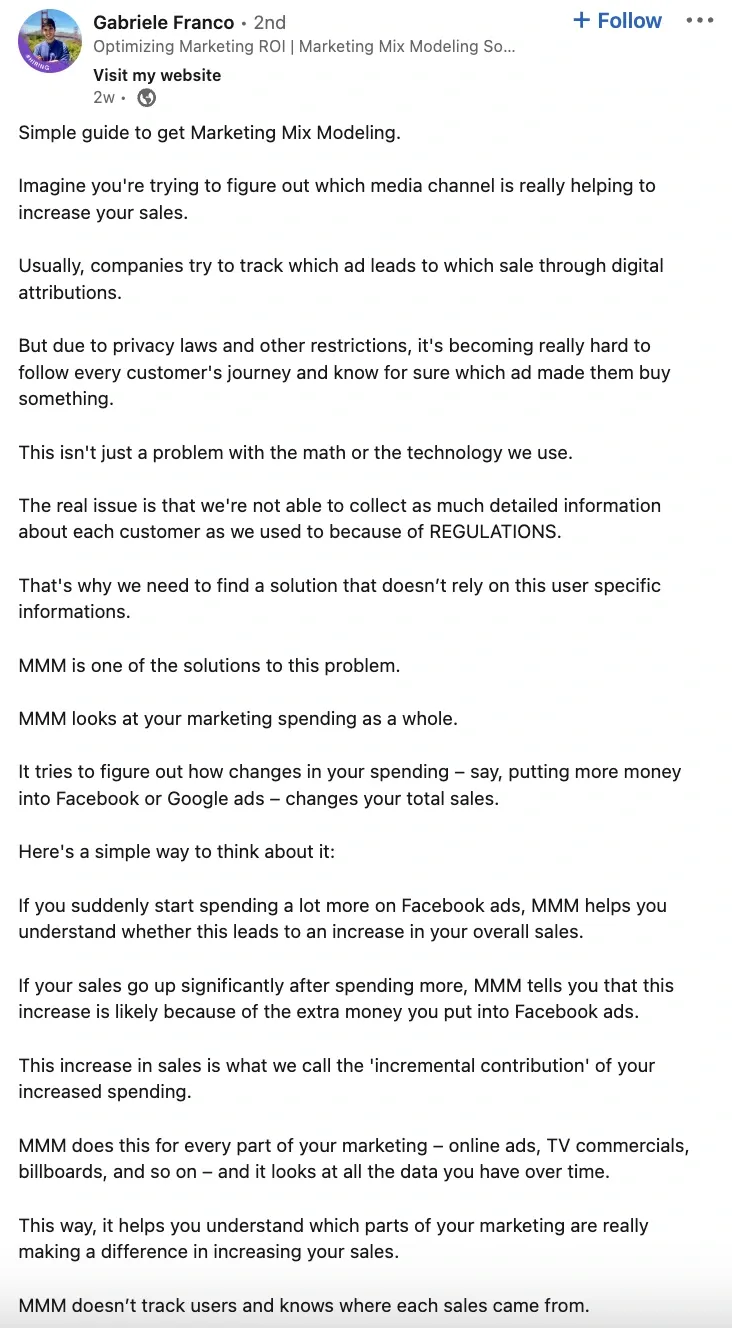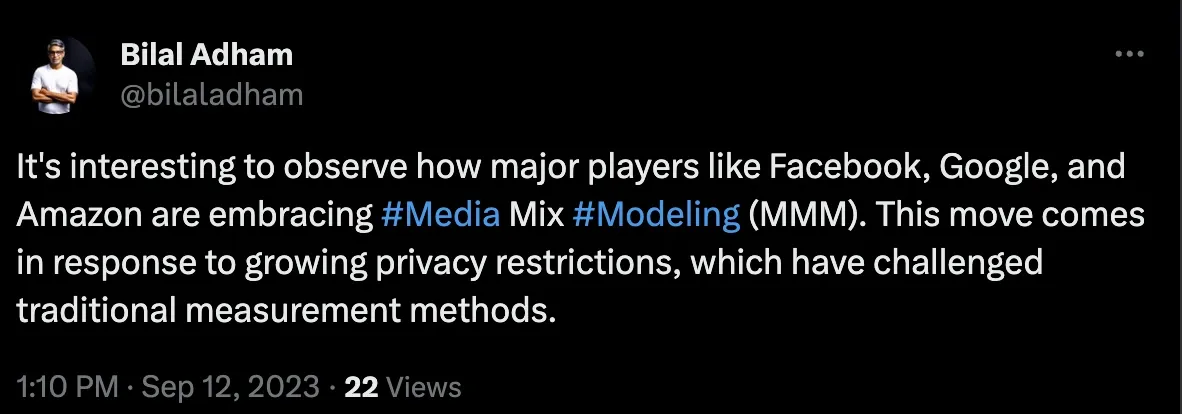Marketing Mix Modeling (MMM) and Media Mix Modeling (MxM) are often mistakenly used interchangeably. However, there are distinct differences between the two. If you are here, you likely understand that media mix and marketing mix models deal with different types of marketing data.
Media Mix Modeling analyzes the effectiveness of different media channels within the marketing mix to optimize the advertising spend and maximize ROI. On the other hand, Marketing Mix Modeling measures the impact of various marketing elements, including external factors like political scenarios, inflation, recession, seasonality, and natural disasters, to understand their effect on sales and marketing ROI.
This article is all set to explain you about Marketing Mix Modeling vs Media Mix Modeling (and some similarities) between the two MMMs.
Understanding Marketing Mix Modeling
Marketing mix modeling helps to identify the impact of different marketing initiatives on the overall ROI. It is a holistic approach focusing on external factors (political, environmental, economic, financial) and analyzing the extent to which these factors influence the performance of a marketing campaign.
A marketing mix model applies statistical methods like correlation trend analysis to understand how the internal and external variables are associated with impacting the sales or ROI of a brand.
In the image below, Gabriele Franco, founder of Cassandra, discusses only marketing mix modeling. He explains what problems B2B brands encounter in measuring campaign effectiveness and why MMM is the easiest solution available:
Linkedin post on marketing mix modeling by gabriele franco 
Components of Marketing Mix Modeling
The components of a marketing mix model are as follows:
- Product – The item a brand offers. Success hinges on understanding the customer’s needs and differentiating your product from competitors.
- Place – This refers to distribution channels or locations where the product is sold, not just the marketing channel being analyzed.
- Promotion – This involves all promotional activities and their collective impact on ROI.
- Price – A crucial element that influences the success of marketing campaigns based on how pricing strategies affect customer behavior.
Data types used in marketing mix modeling
The data inputs required in marketing mix modeling are segregated into three categories:
- KPI-based data – Sales over time, product category sales, loyalty program data, and geographical sales data.
- Marketing data – promotional data, campaign budget vs spends, channel-specific campaign spending, organic spending.
- External data – Seasonal trends, discounts data, changing market trends.
Deep Dive into Media Mix Modeling
Media Mix Modeling is a focused approach that zeroes in on the performance of individual media channels like television, social media, and advertising platforms. It leverages historical data to offer insights into campaign performance and future potential.
Bilal Adham, Group Vice President at DP World, explains why major players like Facebook Amazon are slowly shifting to media mix modeling in the below image:
major players like Facebook Amazon are slowly shifting to media mix modeling post by bilal adham
Drivers of Media Mix Modeling
Brands segregate their media mix modeling initiatives and outcomes depending on the following drivers:
- Base drivers – Outcomes from existing brand recognition without paid marketing
- Incremental drivers – Results from paid marketing activities.
- Other drivers – Significant outcomes not classified under base or incremental drivers.
Data types used in Media Mix Modeling
Media Mix Modeling is focused on channel-specific data, including
- Sales data – Conversion metrics across different platforms.
- Customer data – Demographic information and buying habits.
- Spend data – media spend breakdown for multiple marketing channels.
Marketing Mix Modeling vs Media Mix Modeling – Comparative Analysis
While both models aim to optimize marketing resource allocation, they differ significantly in approach and data utilization:
But that’s not all. The approaches and data types used in media mix modeling and marketing mix modeling are largely different. Here’s a comparative analysis of both:
| Factors | Marketing mix modeling | Media mix modeling |
| Goal | To offer a holistic overview of all factors (internal and external) affecting the marketing performance of a business. | To identify channel-specific factors on a deeper level that optimize the advertising spend of a campaign to achieve desired results. |
| Scope | Focused on category-level performance measurement, MMM helps marketers develop an integrated overview of the market category as a whole and not just a brand-specific overview. | Brand-level overview of the marketing mix. This approach focuses on data-driven insights from one or more media channels to measure the impact of advertising. |
| Data types | KPI-based data, marketing data, and non-marketing external factors. | Sales data, customer data, and campaign spending data. |
| Key question | Which internal and external factors are the key driving factors in the sales revenue generated from advertising campaigns? | How do you achieve the maximum impact from your advertising campaigns? |
Ultimately, it all comes down to your goal and requirements when deciding between the marketing and media mix models.
The marketing mix model is beneficial when you want to:
- Evaluate the efficacy of various marketing channels, both online and offline.
- Determine optimal spending per channel.
- Expand reach economically.
Media mix modeling is best suited when you want to:
- Investigate a specific channel’s contribution to overall ROI.
- Gain a detailed performance overview for targeted marketing initiatives.
Marketing Mix Modeling Use Case
Here is Marketing Mix Modeling Use Case of an FMCG brand and its strategic shift to MMM led to a 15% increase in marketing ROI.
Problems
- Identifying the influence of specific marketing channels like TV commercials, online ads, radio ads, and print media on overall ROI
- Complicated data sources integrations leading to a time-consuming process
- Inability to allocate budgets effectively, leading to identifying the contribution of each channel in overall sales growth
Solutions
- Performing regression analysis on different data types like sales, marketing, spending, and competitor actions to build the MMM.
- Conducting scenario analysis with MMM to get comprehensive insights into budgeting and improving marketing decision-making.
Results
- Increased ROI by 15%
Use Case for Media Mix Modeling
Suppose you run an ecommerce store selling luxury bags. Currently, your target marketing channels are:
- Facebook, Google, TikTok, and Instagram advertising
- Organic social media promotions
- Television advertisements
You have implemented media mix modeling to get data-driven insights into which of these channels contribute the most to your overall sales ROI.
Here are the possible insights a media mix modeling will derive in the case of the ecommerce store:
- How many products were purchased from each media channel?
- What is the ROI derived from each media channel for a particular timeframe?
- What is the optimal level of spend associated with each marketing channel for a specific timeframe?
- What should be the ad spend from each channel in the coming year based on historical performance?
To get these insights, a media mix modeling will demand the following data inputs from the ecommerce store:
- No purchases over the defined timeframe
- Ideal customer profile involving the demographic data of each customer
- Spend breakdown for each marketing channel
Start your Marketing Mix Modeling Journey with Lifesight
Now that you have a clear idea about marketing mix modeling vs media mix modeling, it is time to try both approaches.
Starting with marketing mix modeling is a smarter idea, as you need a holistic overview of your marketing initiatives before diving deeper into a specific channel.
The perfect tool to begin your association is with Lifesight’s marketing mix modeling(MMM), which helps brands:
- Get a clear overview of the channel-wise performance of multiple campaigns and recommendations on the next steps
- Forecast on upcoming campaign performance based on historical data analysis
- Create customized MMM that fulfill your business goals and KPIs
Want to cut down unnecessary ad budgets and predict future outcomes accurately?
You may also like
Essential resources for your success

























































